PARAQUAT
 Paraquat is a quaternary ammonium herbicide. Other members of this class include diquat, cyperquat, diethamquat,
difenzoquat and morfamquat. Pesticides are known to be associated with an increased rate of Parkinson's Disease. Paraquat
structurally resembles MPTP and its metabolite MPP+. MPTP and MPP+ are neurotoxic chemicals, that induce Parkinson's Disease
in exposed humans. Paraquat might therefore might, as do MPTP and MPP+ inhibit tyrosine hydroxylation, which is essential
for the formation of dopamine.
Paraquat is a quaternary ammonium herbicide. Other members of this class include diquat, cyperquat, diethamquat,
difenzoquat and morfamquat. Pesticides are known to be associated with an increased rate of Parkinson's Disease. Paraquat
structurally resembles MPTP and its metabolite MPP+. MPTP and MPP+ are neurotoxic chemicals, that induce Parkinson's Disease
in exposed humans. Paraquat might therefore might, as do MPTP and MPP+ inhibit tyrosine hydroxylation, which is essential
for the formation of dopamine.
ROTENONE
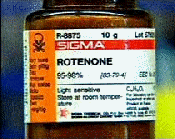 Rotenone is an insecticide that has the potential to cause Parkinson's disease. Insecticides are also known to affect well
water. Rotenone is commonly used in powdered form to treat parasitic mites on chickens and other fowl, and so can be found
in poultry. Rotenone is produced by extraction from the roots, seeds, and leaves of certain tropical legumes. Rotenone inhibits
tyrosine hydroxylation, which is essential for the formation of dopamine. So rotenone could cause Parkinson's disease by lowering
dopamine levels. When given intravenously to mice, rotenone has been demonstrated to cause a model of Parkinson's disease.
Rotenone toxicity is also caused by complex I inhibition, depletion of cellular and oxidative damage. These processes cause
loss of midbrain dopaminergic neurons, leading to depletion of dopamine in the brain.
Rotenone is an insecticide that has the potential to cause Parkinson's disease. Insecticides are also known to affect well
water. Rotenone is commonly used in powdered form to treat parasitic mites on chickens and other fowl, and so can be found
in poultry. Rotenone is produced by extraction from the roots, seeds, and leaves of certain tropical legumes. Rotenone inhibits
tyrosine hydroxylation, which is essential for the formation of dopamine. So rotenone could cause Parkinson's disease by lowering
dopamine levels. When given intravenously to mice, rotenone has been demonstrated to cause a model of Parkinson's disease.
Rotenone toxicity is also caused by complex I inhibition, depletion of cellular and oxidative damage. These processes cause
loss of midbrain dopaminergic neurons, leading to depletion of dopamine in the brain.
MANEB
Maneb is a fungicide that contains manganese. The major active element of Maneb is manganese ethylene-bis-dithiocarbamate.
Pesticides are known to be associated with an increased rate of Parkinson's  disease, so there is a
disease, so there is a greatly increased likelihood of developing toxic symptoms by people involved in horticulture and agriculture. As Maneb contains
manganese it is possible that it causes Parkinson's Disease symptoms via the same means as manganese, which is by inhibiting
tyrosine hydroxylation, which is essential for the formation of dopamine. The effects of Maneb are potentiated when there
is simultaneous exposure to the pesticide Paraquat.
greatly increased likelihood of developing toxic symptoms by people involved in horticulture and agriculture. As Maneb contains
manganese it is possible that it causes Parkinson's Disease symptoms via the same means as manganese, which is by inhibiting
tyrosine hydroxylation, which is essential for the formation of dopamine. The effects of Maneb are potentiated when there
is simultaneous exposure to the pesticide Paraquat.
MANGANESE
Manganese can cause manganism, an irreversible neurological disorder similar to Parkinson's disease. Occupational
exposures occur mainly in welding, mining as miners are surrounded by manganese dust and airborne manganese  particles, alloy production, processing, ferro-manganese operations especially in which manganese ore or manganese compounds
are turned into steel, and work with agrochemicals. The towns and communities surrounding the areas of manganese heavy industry
could also become affected by toxic exposure to manganese. It is also hypothesized that long-term exposure to the naturally-occurring
manganese in shower water also puts people at risk. Manganese inhibits tyrosine hydroxylation, which is essential for the
formation of dopamine. So manganese may cause Parkinson's disease by lowering dopamine levels.
particles, alloy production, processing, ferro-manganese operations especially in which manganese ore or manganese compounds
are turned into steel, and work with agrochemicals. The towns and communities surrounding the areas of manganese heavy industry
could also become affected by toxic exposure to manganese. It is also hypothesized that long-term exposure to the naturally-occurring
manganese in shower water also puts people at risk. Manganese inhibits tyrosine hydroxylation, which is essential for the
formation of dopamine. So manganese may cause Parkinson's disease by lowering dopamine levels.
MPTP
MPTP (1-methyl 4-phenyl 1,2,3,6-tetrahydropyridine) is a chemical that may be produced accidentally during
illicit manufacture of the recreational drug MPPP, which is a synthetic heroin substitute. The neurotoxicity of MPTP was  discovered in 1976 after a chemistry graduate student synthesized MPPP incorrectly and injected the result. It was contaminated
with MPTP, and within three days he began exhibiting symptoms of acute Parkinson's disease. It was also developed but unused
as a herbicide and was distributed on the streets as a synthetic opioid-like drug. MPTP inhibits tyrosine hydroxylation, which
is essential for the formation of dopamine. So MPTP causes acute Parkinson's disease by lowering dopamine levels.
discovered in 1976 after a chemistry graduate student synthesized MPPP incorrectly and injected the result. It was contaminated
with MPTP, and within three days he began exhibiting symptoms of acute Parkinson's disease. It was also developed but unused
as a herbicide and was distributed on the streets as a synthetic opioid-like drug. MPTP inhibits tyrosine hydroxylation, which
is essential for the formation of dopamine. So MPTP causes acute Parkinson's disease by lowering dopamine levels.
TOLUENE
 Toluene is a solvent that has been shown to cause Parkinson's Disease, or that has been associated with people with Parkinson's
disease. Toluene is used as an octane booster in fuel, as a solvent in paints, paint thinners, chemical reactions, rubber,
printing, adhesives, lacquers, leather tanning, disinfectants, and to produce phenol and TNT (a component of explosives).
It is also used as a raw material for toluene di-isocyanate, which is used in the manufacture of polyurethane foams. The precise
means of toxicity of toluene is not known.
Toluene is a solvent that has been shown to cause Parkinson's Disease, or that has been associated with people with Parkinson's
disease. Toluene is used as an octane booster in fuel, as a solvent in paints, paint thinners, chemical reactions, rubber,
printing, adhesives, lacquers, leather tanning, disinfectants, and to produce phenol and TNT (a component of explosives).
It is also used as a raw material for toluene di-isocyanate, which is used in the manufacture of polyurethane foams. The precise
means of toxicity of toluene is not known.
N-HEXANE
 N-hexane, a constituent of solvents has been shown to cause parkinsonism. Most of the n-hexane used in industry is mixed with
similar chemicals called solvents. The major use for solvents containing n-hexane is to extract vegetable oils from crops
such as soybeans. These solvents are also used as cleaning agents in the printing, textile, furniture, and shoe making industries,
and also by chemists. Certain glues used in the roofing, and shoe and leather industries also contain n-hexane. Several consumer
products contain n-hexane, such as gasoline, spot removers, quick-drying glues, and also rubber cement. The precise
means of toxicity of n-hexane is still unknown.
N-hexane, a constituent of solvents has been shown to cause parkinsonism. Most of the n-hexane used in industry is mixed with
similar chemicals called solvents. The major use for solvents containing n-hexane is to extract vegetable oils from crops
such as soybeans. These solvents are also used as cleaning agents in the printing, textile, furniture, and shoe making industries,
and also by chemists. Certain glues used in the roofing, and shoe and leather industries also contain n-hexane. Several consumer
products contain n-hexane, such as gasoline, spot removers, quick-drying glues, and also rubber cement. The precise
means of toxicity of n-hexane is still unknown.
CARBON DISULFIDE
 Carbon disulfide, usually in solvents or pesticides, can cause Parkinson's disease that is associated with other neurological
symptoms. The toxic effects can persist for years after exposure to the carbon disulfide has ceased. Potential sources include
pesticides used as fumigants, disulfiram (a drug used in the treatment of chronic alcoholism), industrial solvents, solvents
used in the production of viscose rayon and cellophane film. Means of toxicity is not established. However, carbon disulphide
interferes with pyridoxal 5-phosphate. Pyridoxal 5-phosphate is essential for the formation of dopamine from L-dopa. So carbon
disulphide may cause Parkinson's disease symptoms by reducing the formation of L-dopa.
Carbon disulfide, usually in solvents or pesticides, can cause Parkinson's disease that is associated with other neurological
symptoms. The toxic effects can persist for years after exposure to the carbon disulfide has ceased. Potential sources include
pesticides used as fumigants, disulfiram (a drug used in the treatment of chronic alcoholism), industrial solvents, solvents
used in the production of viscose rayon and cellophane film. Means of toxicity is not established. However, carbon disulphide
interferes with pyridoxal 5-phosphate. Pyridoxal 5-phosphate is essential for the formation of dopamine from L-dopa. So carbon
disulphide may cause Parkinson's disease symptoms by reducing the formation of L-dopa.
CARBON MONOXIDE
Carbon monoxide toxicity is frequent due to the formation of carbon monoxide by very common means such as
gas cookers and exhaust fumes. However, it normally requires severe exposure (e.g. the person going into a coma as a 
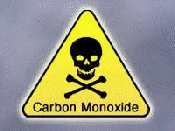 result of the carbon monoxide poisoning) before symptoms of Parkinson's disease develop. Carbon monoxide causes hemoglobin
(which transports oxygen) to turn in to carboxyhemoglobin (which does not transport oxygen). Oxygen is required for the formation
of L-dopa. So carbon monoxide may cause Parkinson's disease symptoms by interfering with the availability of oxygen to the
brain. However, the precise means by which it can cause parkinsonism has still not been proven.
result of the carbon monoxide poisoning) before symptoms of Parkinson's disease develop. Carbon monoxide causes hemoglobin
(which transports oxygen) to turn in to carboxyhemoglobin (which does not transport oxygen). Oxygen is required for the formation
of L-dopa. So carbon monoxide may cause Parkinson's disease symptoms by interfering with the availability of oxygen to the
brain. However, the precise means by which it can cause parkinsonism has still not been proven.
MERCURY
Mercury toxicity is a known cause of symptoms that mimic Parkinson's disease, especially tremor. One of the
chief targets of the toxin is the enzyme pyruvate dehydrogenase (PDH). The enzyme is irreversibly inhibited by several 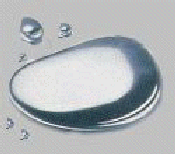 mercury compounds, the lipoic acid component of the multienzyme complex binds mercury compounds tightly and thus inhibits
PDH. However, the cause of the symptoms of Parkinson's disease is likely to be due to the fact that mercury potently causes
the release of dopamine, thereby lowering dopamine levels. Mercury is found in a wide variety of sources: dietary fish intake,
ethnic over-the-counter medications, occupational exposures to mercury vapour, possession of dental amalgam fillings, gold
production, skin ointment, some soaps.
mercury compounds, the lipoic acid component of the multienzyme complex binds mercury compounds tightly and thus inhibits
PDH. However, the cause of the symptoms of Parkinson's disease is likely to be due to the fact that mercury potently causes
the release of dopamine, thereby lowering dopamine levels. Mercury is found in a wide variety of sources: dietary fish intake,
ethnic over-the-counter medications, occupational exposures to mercury vapour, possession of dental amalgam fillings, gold
production, skin ointment, some soaps.
CYANIDE
Cyanide, usually from the consumption of potassium cyanide or sodium cyanide can result in Parkinsonism.
Cyanide is also produced by certain bacteria, fungi, and algae, and are found in a number of foods and plants, such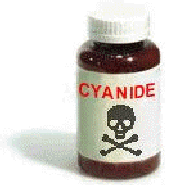 as unprocessed cassava, cherry pits, apricot pits, bitter almonds. Hydrogen cyanide is contained in vehicle exhaust and in
tobacco smoke, as does burning plastic. Cyanides are also found in gold processing. Cyanide interrupts the electron transport
chain in the inner membrane of the mitochondrion. Cyanide also occupies the place of oxygen in hemoglobin (which transports
oxygen). Oxygen is required for the formation of L-dopa. So carbon monoxide may cause Parkinson's disease symptoms by interfering
with the availability of oxygen to the brain. However, the precise toxic means by which it causes Parkinson's disease has
still not been proven.
as unprocessed cassava, cherry pits, apricot pits, bitter almonds. Hydrogen cyanide is contained in vehicle exhaust and in
tobacco smoke, as does burning plastic. Cyanides are also found in gold processing. Cyanide interrupts the electron transport
chain in the inner membrane of the mitochondrion. Cyanide also occupies the place of oxygen in hemoglobin (which transports
oxygen). Oxygen is required for the formation of L-dopa. So carbon monoxide may cause Parkinson's disease symptoms by interfering
with the availability of oxygen to the brain. However, the precise toxic means by which it causes Parkinson's disease has
still not been proven.
COPPER
Copper accumulates in Wilson's disease, which is associated with Parkinson's disease. Although copper may
cause symptoms by other means, there do not appear to be published studies in which copper has otherwise caused Parkinson's disease.
This may be because copper is not normally formed in to a vapour or dust that can readily be inhaled or consumed. Copper can
be found in high quantities in copper mines, copper cooking pots, copper plumbing, very excessive consumption of copper nutritional
supplements. Excess copper can cause the formation of a copper-dopamine complex, which leads to the oxidation of dopamine
to aminochrome.
symptoms by other means, there do not appear to be published studies in which copper has otherwise caused Parkinson's disease.
This may be because copper is not normally formed in to a vapour or dust that can readily be inhaled or consumed. Copper can
be found in high quantities in copper mines, copper cooking pots, copper plumbing, very excessive consumption of copper nutritional
supplements. Excess copper can cause the formation of a copper-dopamine complex, which leads to the oxidation of dopamine
to aminochrome.
LEAD
Prolonged exposure to lead can double the likelihood of developing Parkinson’s Disease. Common means
of lead poisoning are lead contaminated soil, and ingestion of lead dust or chips from deteriorating lead-based paints. Lead
 has also been found in drinking water, from plumbing and fixtures that are either made of lead or have trace amounts of lead
in them. Lead can be found in cosmetics in some countries, and in toys such as many from China. Due to the similarity of their
structures, lead can inadvertently replace iron in enzymatic reactions, but it does not properly function as a cofactor. This
might cause a reduction in L-dopa because iron is an essential cofactor for L-dopa formation. Lead can also interfere with
oxygen transport by reducing hemoglobin biosynthesis.
has also been found in drinking water, from plumbing and fixtures that are either made of lead or have trace amounts of lead
in them. Lead can be found in cosmetics in some countries, and in toys such as many from China. Due to the similarity of their
structures, lead can inadvertently replace iron in enzymatic reactions, but it does not properly function as a cofactor. This
might cause a reduction in L-dopa because iron is an essential cofactor for L-dopa formation. Lead can also interfere with
oxygen transport by reducing hemoglobin biosynthesis.
Trichloroethylene
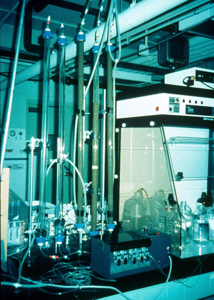 People subjected to chronic industrial exposure of the solvent Trichloroethylene have been found to have Parkinson’s
Disease. Trichloroethylene is a solvent, that is used extensively in industry and the military and is a common environmental
contaminant. It has been used to extract vegetable oils, in coffee decaffeination, and in the preparation of flavouring extracts
from hops and spices. The precise means of toxicity is unknown. Workers with workstations adjacent to the source of trichloroethylene
and who were subjected to chronic inhalation and dermal exposure from handling trichloroethylene-soaked metal parts all had
Parkinson's disease. Lesser chronic respiratory exposure to trichloroethylene led to many features of Parkinsonism, including
significant motor slowing.
People subjected to chronic industrial exposure of the solvent Trichloroethylene have been found to have Parkinson’s
Disease. Trichloroethylene is a solvent, that is used extensively in industry and the military and is a common environmental
contaminant. It has been used to extract vegetable oils, in coffee decaffeination, and in the preparation of flavouring extracts
from hops and spices. The precise means of toxicity is unknown. Workers with workstations adjacent to the source of trichloroethylene
and who were subjected to chronic inhalation and dermal exposure from handling trichloroethylene-soaked metal parts all had
Parkinson's disease. Lesser chronic respiratory exposure to trichloroethylene led to many features of Parkinsonism, including
significant motor slowing.
